Hooking up a trailer to your car or truck is an easy way to increase the storage capacity of your vehicle. However, failing to attach your trailer correctly can lead to damage to your own car, the trailer, and other vehicles around you as you drive. By securing the coupler to the hitch ball on your vehicle, making sure that it’s locked in properly, and wiring up the lights, you can hook up a trailer safely and easily.
StepsPart 1Part 1 of 3:Lining up Your Vehicle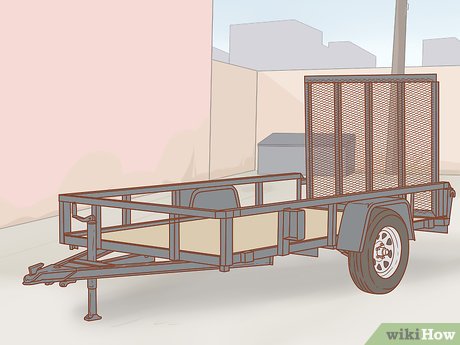
1Move the trailer to a long, easily accessible area. While it’s possible to reverse towards a trailer on an angle or around corners, it’s much easier to attach your trailer if you approach it in a straight line. If you can, wheel the trailer to a long stretch of a driveway or a parking lot where you’ll have plenty of room to work.XMost trailers will have an attached jack with a wheel on the end that can help keep the trailer level without it being attached to anything. Keep this out while moving the trailer by hand to reduce some of the heavy lifting.If your trailer is already full, it might be more difficult to move by hand. Rotate it on the spot as much as you can to make the reversing job easier, as trying to move it yourself may be difficult.
2Reverse your vehicle in a straight line with the trailer. Drive your vehicle forward so that it is directly in front of the trailer. Slowly reverse the car, turning the wheel slightly to keep it as directly in line with the trailer as you can. Stop when the back of the car is around 1 foot (0.30 m) away from the front of the trailer.XReversing your car into the right position and space is much easier when you have a lot of room to work with.Keeping the trailer and vehicle lined up properly will make driving much easier, especially when you’re first getting onto the road.It might help to get a friend or someone else to help you reverse the car. They can guide you on how far back to drive and help you correct the vehicle if it starts angling in one direction.
3Position the trailer coupler slightly above the hitch ball. The trailer coupler is the metal socket on the end of the trailer that will connect to the back of your car. Rotate the handle on the trailer jack to raise or lower the coupler so that it’s 2 to 3 inches (5.1 to 7.6 cm) above the hitch ball on the back of your car.XIf your trailer doesn’t have an attached jack, you could use a regular car jack to hold the trailer at the right height.Attached trailer jacks will be slightly behind the coupler on the trailer.If the trailer is light enough and easy to move, you could simply lift the trailer coupler forward and place it over the hitch ball.The hitch ball is the metal ball on the back of your car that the trailer coupler will attach to.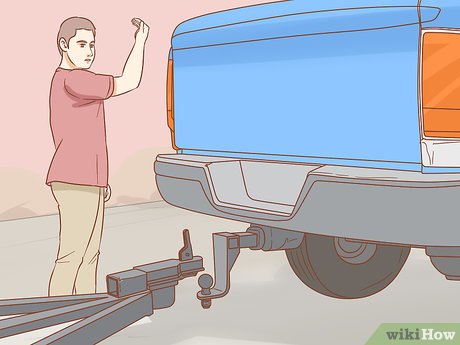
4Back your vehicle up until the coupler is directly above the hitch ball. With the coupler raised a little above the hitch ball, get back into your vehicle and reverse backward a little further. Get a friend to help guide you to reverse your car so that the hitch ball and coupler are perfectly lined up.XIt’s possible to reverse into position by yourself, but it will take a lot of trial and error. Reverse a little bit, put on the break, and get out to check how much further back you need to go. Repeat this process until everything is lined up.If you reverse too far back, you may hit the coupler and scratch or damage the back of your car.Part 2Part 2 of 3:Securing the Trailer
1Unlock the trailer coupler latch. The latch on top of the trailer coupler is the first mechanism that will keep your trailer locked onto the back of your car. Remove the latch pin from the trailer coupler and lift the latch upwards to unlock it. This will allow it to sit on the hitch ball on your vehicle.XSome trailers might have methods other than latch pins used to hold the latch in place. Try to raise the latch and see what’s holding it in place to find the right way to release it.The latch will likely be a metal handle on top of the trailer coupler.If the coupler is already unlocked, you can skip this step.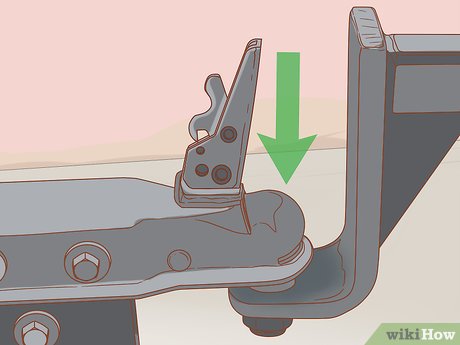
2Lower the coupler socket onto the vehicles hitch ball. Check the hitch ball on the back of your vehicle and remove any covers or protectors sitting on top of it. Use the handle attached to the trailer jack to lower the coupler socket onto the hitch ball, until the weight of the trailer is supported entirely by the ball.XIf the latch has been lifted and everything is positioned properly, the socket should lower and sit perfectly on the hitch ball.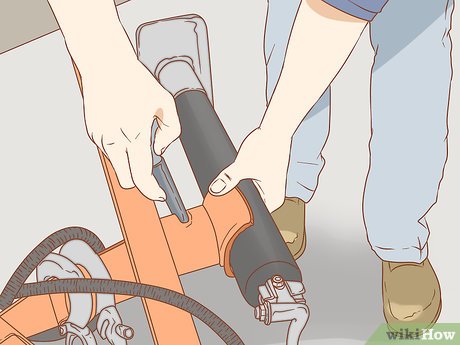
3Move the trailer jack out of the way. The trailer jack is great for positioning the trailer properly but will get easily damaged if you drive with it attached. Look for a latch or latch pin on the trailer jack to rotate it up into the trailer and hold it out of the way while you drive. Alternately, you may be able to detach the jack entirely and keep it in your vehicle until it’s needed.XThe wheel on the trailer jack is not designed for use while driving. Do not drive with the trailer jack on or extended at risk of damaging the trailer, your vehicle, or other vehicles on the road.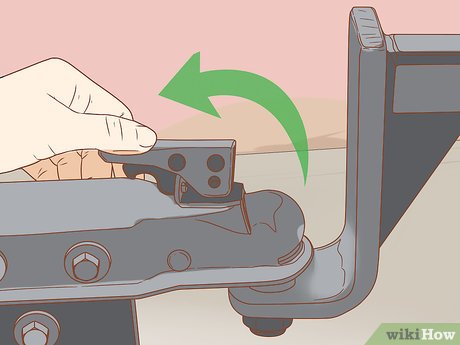
4Lock the coupler latch and insert the latch pin. With the coupler sitting securely on the hitch ball, reverse the process of unlocking the coupler latch to lock it in place. Push the handle on the coupler down so that it is parallel to the ground. Insert the latch pin to hold it in place and prevent the coupler from unlocking while you drive.XDifferent trailers and trailer couplers may have slightly different locking mechanisms. Always consult the owner’s manual for your own trailer to make sure you lock it into place properly.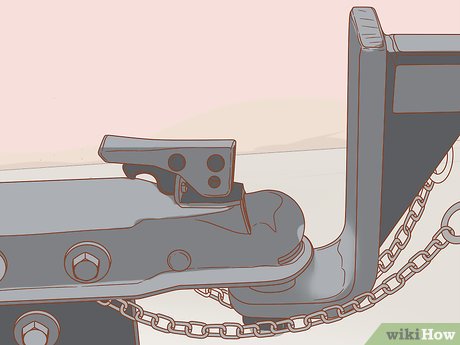
5Attach the safety chains to the back of your vehicle in a cross pattern. Run one of the safety chains below the coupler and hitch ball and attach it to the opposite side of the hitch ball. Repeat with the other chain to create an overlapping cross underneath the coupler and hitch ball.XThe safety chains will be the last safety mechanism in place if the coupler latch fails, so they are legally required in many places.If the coupler disconnects from the vehicle while you’re driving, it will fall and land on the crossed chains rather than hitting the road.The safety chains will be attached to your trailer, just below the coupler.Part 3Part 3 of 3:Connecting the Lights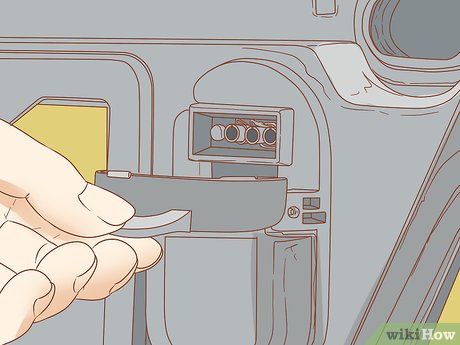
1Locate the wiring socket on the back of your vehicle. The wiring socket is a wide plug that will power the lights on your trailer. Look for a small panel on the back of your vehicle, inside the trunk, or even a loose wire close to the hitch ball. Make sure it isn’t damaged and is free from any corrosion that may prevent it from working properly.XIf you cannot find the wiring socket on your car, check the manufacturer’s instructions for your car for further assistance.If your wiring socket is damaged, corroded, or frayed in any way, have it looked over by a mechanic before plugging the trailer wire into it.
2Plug the trailer wire into your vehicle. There should be a loose wire with a plug on one end near the trailer coupler. Run the wire above the coupler and the hitch ball and plug it into the socket on the back of your vehicle. Press the plug securely into the socket and use any latches on the wire to hold them together.XSome trailers will have metal loops along the side of the coupler that the wire can be threaded through to keep it out of the way.Avoid running the wire underneath the coupler and hitch ball, as this will increase the chances of it getting damaged or becoming unplugged should the trailer detach from your vehicle.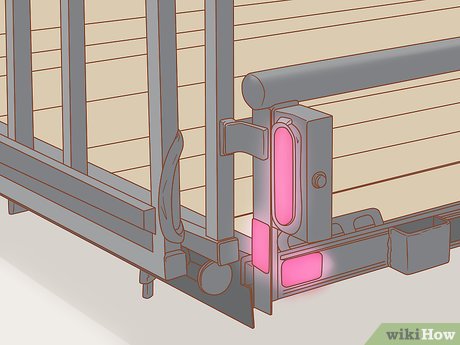
3Test the headlights, blinkers, and brake lights on the trailer. Before you start driving, you should always make sure the trailer lights are working. Start your vehicle, engage the handbrake, and turn on the headlights. Check the appropriate lights on the back of the trailer are on, before repeating the same process with each indicator and the brake lights.XIf any of the lights aren’t working, you should not drive the trailer. This is the same as driving without the corresponding light on your car working. Call a mechanic to ask for assistance before driving your car with the trailer attached.Rather than moving back and forth from the driver’s seat of your car to the rear end of your trailer, ask a friend to check the lights while you activate them.








